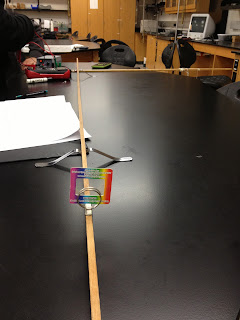2012/11/17
In this activity, from the formula we just derived h=eVlumda/c, we can measure the voltage across the LED and lumda we can use the formula lumda=dsin(theta), where sin(theta)=l/sqrt(l^2+L^2). The values, e and c are known constants.So we can calculate the h.
First, we set up the equipment. The picture shown below is to measure the l and L to calculate the wavelength lumda.
Then we need a power source which is adjusted to 3V, and connect to a resistor and LED. We change the resistance when the LED looks dim then measure the voltage across the LED by using Voltagemeter.
Then we put the LED on the other side like the first picture and measure l and L for each LED.
Here is the data we measure and record. Since we know l,L and d, we can calculate the lumda for each LED.
After we measure all the voltages and wavelengths for each LED,then we can use the formula to calculate h. h=eVlumda/c.
As you can see, the error between our measurement and theoretical value is so big. I guess the big error cause from the voltage. It is so hard to make the LED looks dim. Furthermore, the wavelength we measure and calculate is OK, so the only problem in our activity is measuring the voltage across the LED.








































